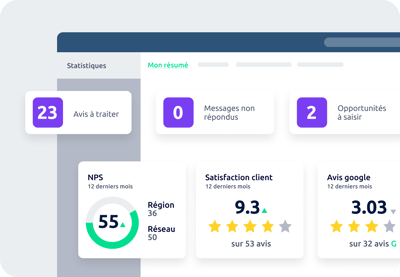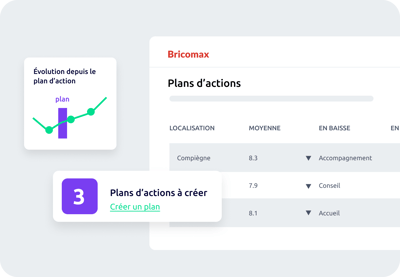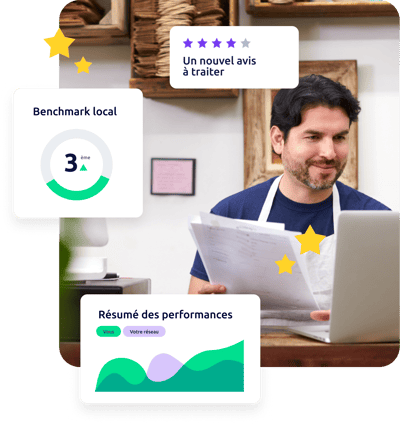How to measure the ROI of customer satisfaction management?
by Sebastien Neveu on 6 April 2023

Most retailers are implementing customer experience programs. They design and deploy action plans to improve customer satisfaction in their network.
This is probably the case for you.
But do you know exactly what the ROI of your customer satisfaction management is?
What is the investment in customer satisfaction management?
Unfortunately, the question is more complicated than it seems.
To answer it, you must accurately assess your investment in customer satisfaction management. By definition, this investment covers a range of large and small actions, both at the headquarters level (marketing department, customer service, loyalty programs, etc.) and local teams.
The benefits of customer satisfaction management should then be measured in terms of performance improvement. But here again, attribution takes work. So, in addition to the choice of satisfaction indicators (NPS®*, CSAT...) and the associated KPIs (measurement indicators), there is the issue of interpreting the results: When your sales increase, to what extent does this increase in turnover come from your satisfaction management actions?
 Do you know?
Do you know?
At best, you can say that while you have increased your NPS®* by X points, your turnover has increased by X% simultaneously. And, therefore, it works...
But let's be serious. Does it make sense if you don't include the amount invested in increasing your NPS®* (Net Promoter Score)?
So how do you do it? Can we measure the ROI of customer satisfaction management?
Not only is it possible, but it is essential. As you know, "you can only improve what you measure".
In this article, we explain how to proceed.
How much does customer satisfaction management cost?
To measure the ROI (return on investment) of customer satisfaction management, you need to evaluate the benefits you get from it compared to the amounts invested.
A priori, in an ROI calculation, evaluating the investment is the most straightforward part.
However, in this case, determining the amount invested is not apparent. To do so, you have to list what customer satisfaction management covers:
- The measurement and management software solution
- The definition of the customer experience strategy at the company level
- The network animation
- The cost of your loyalty program
- Local actions to improve customer satisfaction
And yes, all that! You can't just say: "We implemented the XYZ solution, and it costs us the annual subscription fee". The cost of satisfaction management is a whole that goes from the definition of the strategy, and the action plans to the execution, including the tools and the human and material resources mobilized.
Let's break it down in detail.
Benefits in terms of customer experience
As for the benefits related to the optimization of your customer experience, we will focus on evaluating ;
- The evolution of the average shopping cart.
- The evolution of your sales overall and per point of purchase.
- The evolution of in-store returns.
- The evolution of the satisfaction rate (customer feedback) / quality of service overall and per point of sale.
- The evolution of the number of new customers.
- The development of the foot traffic in-store.
- The growth of the churn rate
- The evolution of customer retention, the rate of repurchase
- The development of customer dissatisfaction / the number of dissatisfied customers
- The change in the number of tickets (contact points) associated with customer relationship management
-png.png?width=400&height=278&name=Generique%20(2)-png.png)
The cost of the software solution
CThe cost of the software solution
Let's start with the simplest: the cost of your customer experience management software solution.
From this point of view, there are no surprises. You know how much you are paying to the software vendor.
Worldwide, the customer satisfaction management software market is worth about $20 billion annually.
But that $20 billion is just the tip of the iceberg.
To accurately measure your investment in improving customer satisfaction, you must also consider the operational and financial resources deployed.
Defining the customer experience strategy
-png.png?width=400&height=278&name=E-reputation_3%20(1)-png.png) You have invested in a software solution to measure, analyze and eventually get recommendations for action. But this is not an end in itself.
You have invested in a software solution to measure, analyze and eventually get recommendations for action. But this is not an end in itself.
Your goal is to launch or optimize a customer experience strategy.
This is a big task for you to :
- Study your current customers: draw up customer typologies (customer segmentation), map their path, identify their main "pain points".
- Analyze your environment: market overview and your position, benchmark your competitors...
- Identify SMART objectives in terms of customer experience and satisfaction
- Prepare action plans that will then be implemented at all levels: headquarters, regional, local
- Measure the return on your actions
How much time, resources, and money will you devote to these different steps?
Here again, you need customer listening devices (voice of the customer) and solutions to compare yourself to your competitors at a national and local level.
Once you have collected and centralized information, how do you move from field data to define an action plan? How to prioritize the actions to be taken? How to calculate the king?
Network animation
You have come up with an action plan, more or less detailed.
However, your employees have many (more or less good) reasons to drag their feet, from the traditional "we've always done it this way, why change?" and "are you sure that if we do it the way you say, it will have an impact on our turnover?" to "there will always be dissatisfied customers, so why bother".
So, you will have to explain, evangelize, and drive change by leading seminars and workshops and taking the message to your teams in the field. You will have to test actions in pilot stores or regions before replicating them in the rest of the network while taking into account inalienable local specificities.
Once again, you will have to mobilize time, energy, resources and budget. And the fewer arguments you have to demonstrate an impact on future performance, the more complex and expensive it will be.
The declination of the actions at the local level
 Finally, you can move on to the operational implementation of your action plan.
Finally, you can move on to the operational implementation of your action plan.
The teams are encouraged to implement the planned actions. This involves costs in terms of time and resources.
You need, for example, to train your employees in new practices. Then, over a while, you will evaluate the impact of the newly implemented actions, stop some of them and increase others.
It may take several weeks to reap the benefits and see significant improvements.
For all these reasons, estimating the cost of driving customer satisfaction can be challenging. Can you give a precise figure or even a decent range for the cumulative expense?
But the worst is yet to come because, as it stands, it is impossible to predict in advance the ROI of customer satisfaction management.
How much does customer satisfaction management bring in? What is the ROI of the customer experience?
"Customer satisfaction generates loyalty and repurchases. It drives future sales.
We all agree on the principle. Satisfied customers will more likely return to your establishments and recommend your brand to their friends and family.
But how many sales? What additional turnover?
And now, no one is raising their hand.
So yes, the good students will answer me: "Since we implemented our customer satisfaction management program, our turnover has increased by X%".
But what is the proof that the turnover would not have increased anyway? What part of this X% can unambiguously be attributed to your customer satisfaction management?
With traditional customer satisfaction indicators (net promoter score, customer satisfaction score, customer effort score), it is impossible to evaluate.
You observe that your NPS®* increases and your turnover increases. And you tell yourself that the answer is in your NPS®* score. But, when your NPS®* reaches a plateau and stagnates, you notice that your turnover continues to increase.
So what do you think?
Clearly, with the NPS®* approach, it is impossible to link the level of satisfaction and performance at this stage. It is also impossible to know which levers to act in priority to improve sales and, therefore, impossible to mobilize the teams on the subject.
As it stands, there needs to be an indicator to link satisfaction and sales. The WizVille teams have developed this missing link, opening the way to a post-NPS approach, resolutely focused on a ROI approach to customer satisfaction management.
%20(2)-png.png?width=600&height=443&name=tableaux-supple%CC%81mentaires4-03%20(2)%20(2)-png.png)
Conclusion
The ROI of the customer satisfaction management is particularly sensitive when companies look for the slightest gains in competitiveness to improve their customer experience.
However, traditional indicators and solutions could be more effective in selecting the actions that will impact your performance.
The post-NPS®* approach opens the way to a measurable ROI and predictive practice of customer satisfaction management by reconciling satisfaction and transactional data. As a result, retailers will be able to reduce their margins of error and better serve their customers by focusing their investments on the items that matter.
* NPS is a registered trademark, and Net Promoter System are service marks, of Bain & Company, Inc., Satmetrix Systems, Inc. and Fred Reichheld.
Do you want to know more about this new approach?
Share this
Related blog posts

3 customer satisfaction indicators you need to monitor now!

CSAT, NPS®*, CES: how to choose your customer satisfaction indicators?

.png?width=9900&height=2126&name=wizville_logo_couleur_fond_blanc%20(1).png)
